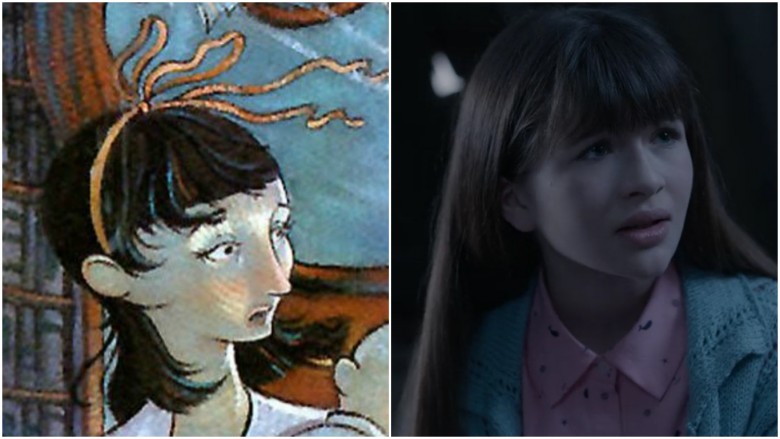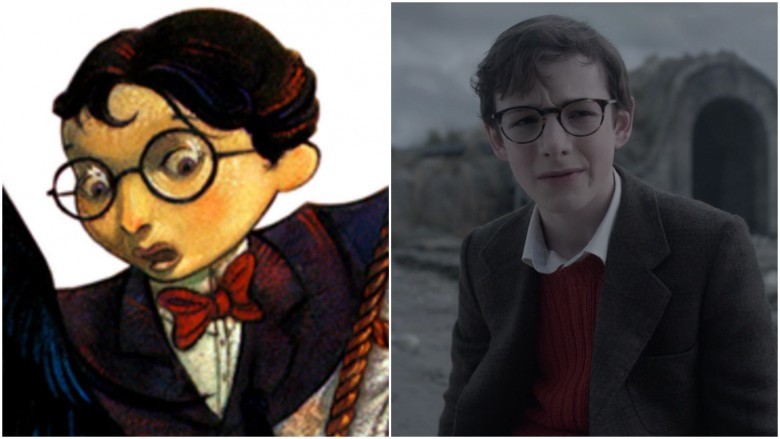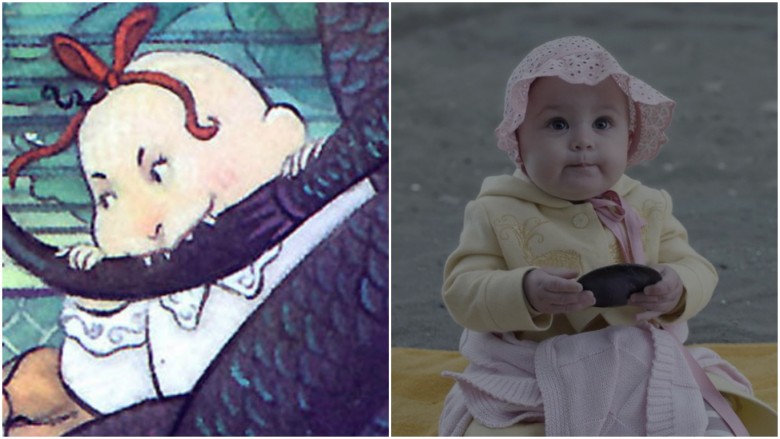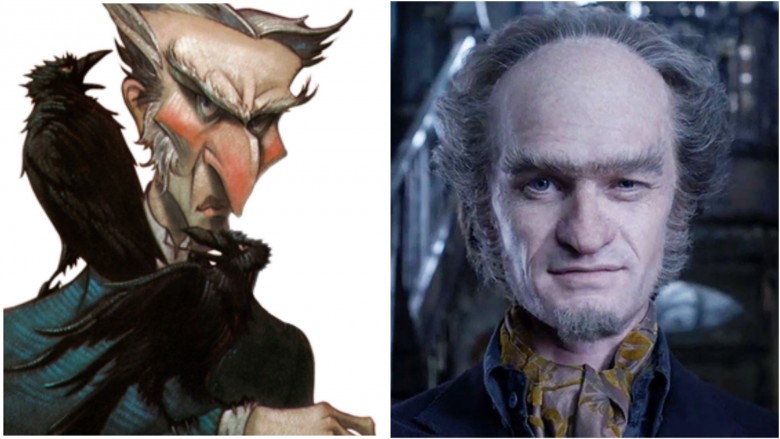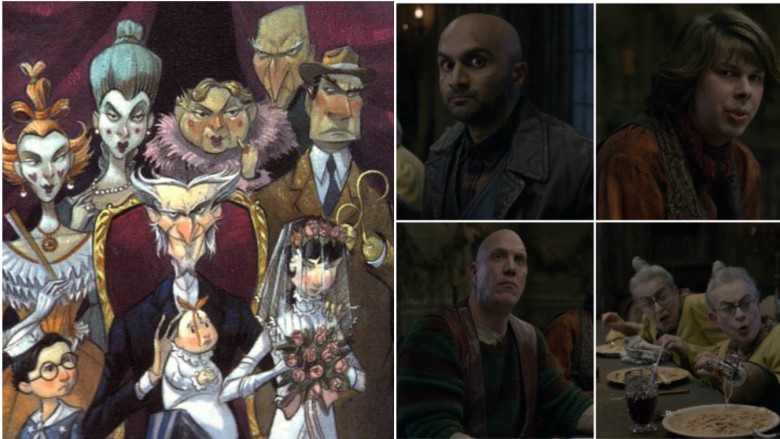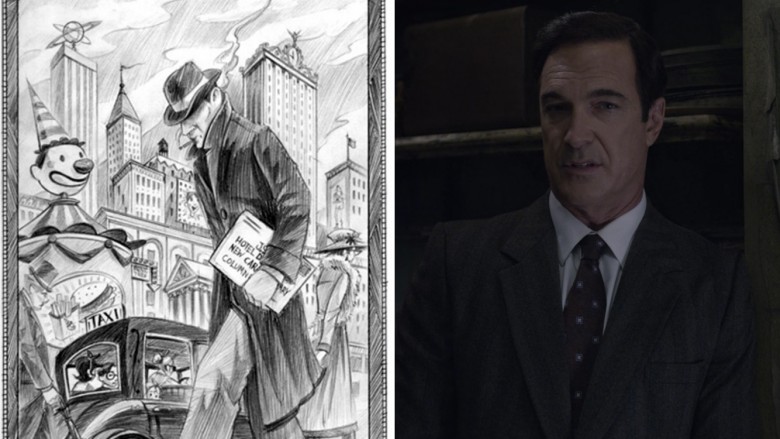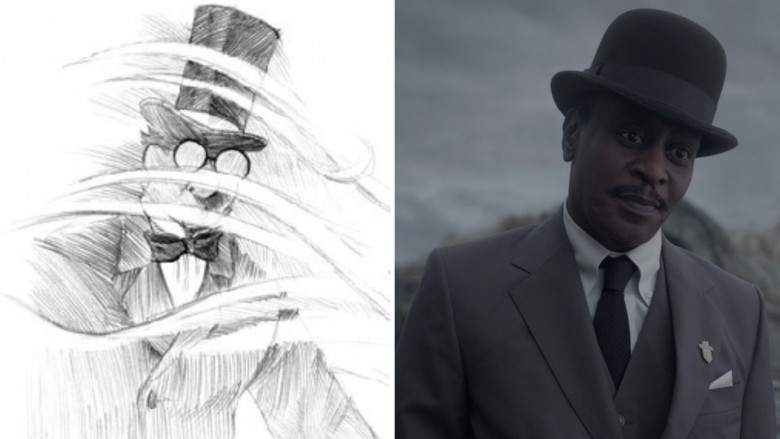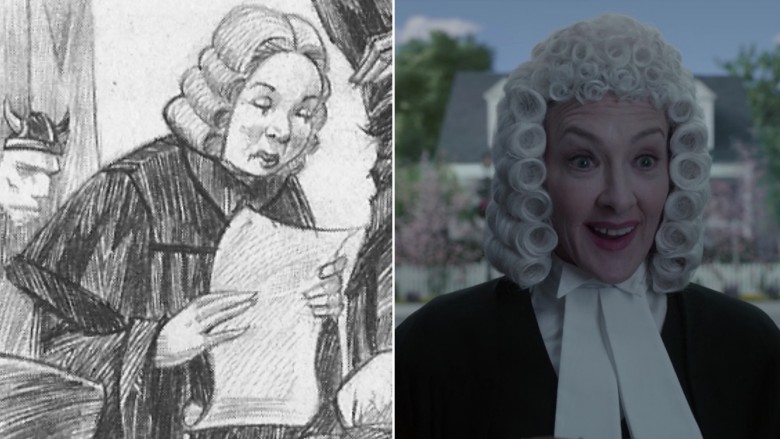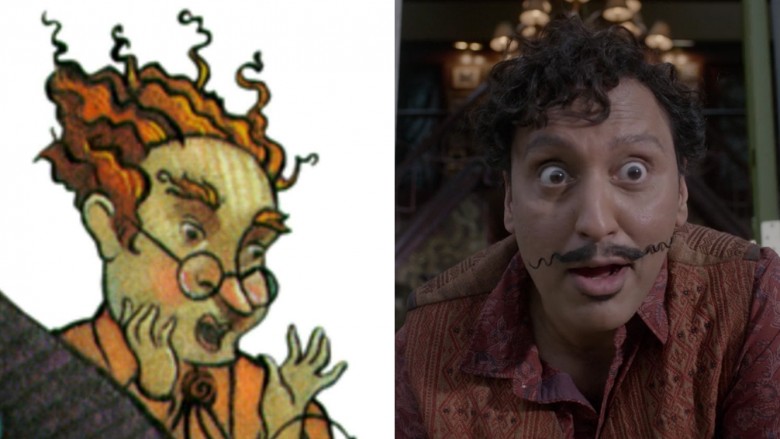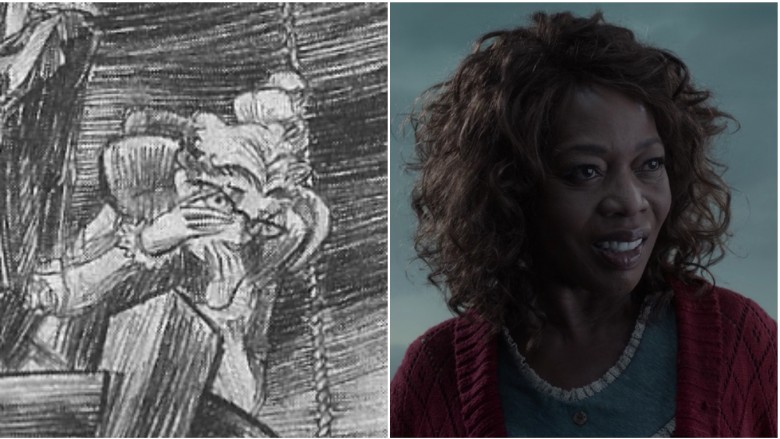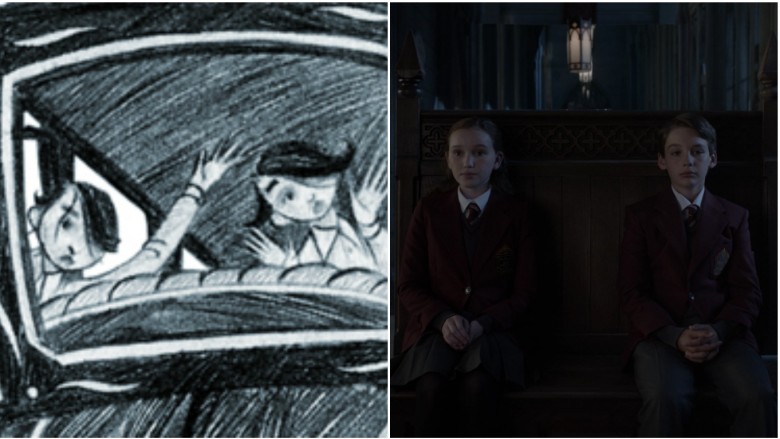How The Cast Of A Series Of Unfortunate Events Should Really Look
Most fans of the children's novel series A Series of Unfortunate Events have been split on the accuracy of screen adaptations, especially when it comes to character depictions. The 2004 film adaptation of the beloved Lemony Snicket-penned books was applauded by many, but some characters were left almost unrecognizable in comparison to their original appearances.
While the recent Netflix adaptation of A Series of Unfortunate Events gets a lot right, there still exist some noticeable differences in the way the actors look as their characters. Here's how the cast of A Series of Unfortunate Events compare to their book counterparts.
Violet Baudelaire
The eldest of the three Baudelaire children, Violet is a bookworm, masterful inventor, and problem solver extraordinaire. Apart from her supreme intelligence, which is highlighted throughout the series, special attention is paid to her hair in the books' descriptions. It's long and almost black, flicking softly off her shoulders. As she grows older and as she and her siblings escape increasingly nefarious villains, Violet's hair becomes curlier and more unkempt. And she wouldn't be Violet Baudelaire without her signature ribbon, which she uses to tie up her hair when she's planning her next invention. "Anyone who knew Violet well could tell she was thinking hard, because her long hair was tied up in a ribbon to keep it out of her eyes. Violet had a real knack for inventing and building strange devices," Snicket wrote inThe Bad Beginning, "and she never wanted to be distracted by something as trivial as her hair."
Malina Weissman settles into the role of Violet in the Netflix adaptation with ease, and her appearance is relatively spot-on when stacked up against the books. Slight differences, however, can be seen in Weissman's lighter hair color, longer hair length, and rounder features. The 13-year-old actress's overall appearance isn't as harsh as it is described on the page: Violet's face is fairly angular and her tousled, inky hair creates a stark contrast against her pale skin, but Weissman in the role is notably softer.
Thankfully included in the television series is Violet's trusty ribbon. However, it's a mauve color as opposed to the peach shade seen in the books. Another color change comes with Malina Weissman's blue/green eyes. While Violet's eye color is never specified in the novels, all book-accompanied illustrations show them as dark brown, close to her brother Klaus's.
Klaus Baudelaire
Smarts and specialized skills are familial traits for the Baudelaires, and they're not lost on the middle child, Klaus. His signature glasses "made him look intelligent [and] he was intelligent." Actor Louis Hynes's take on Klaus is fairly similar to Snicket's vision: Hynes has the dark wavy hair, the white button-down worn under a classy suit jacket, and the wise-beyond-his-years facial features. However, there are some snags in the television depiction's accuracy. What's missing are Klaus's ties (in varying shades) and his round-framed black glasses. Hynes is a bit more lax in his appearance as Klaus, going sans tie and sporting some less geometric, tortoiseshell specs. Though the onscreen Klaus isn't a copy-paste portrayal, the changes are minor, and he remains the most authentic live-action translation of the Baudelaire children.
Sunny Baudelaire
As in the books, Sunny Baudelaire packs a pretty serious punch in Netflix's A Series of Unfortunate Events. With tiny tot Presley Smith playing the babbling baby on screen, audiences get an almost exact translation of the character from the Snicket novels. Though Sunny ages out of infancy throughout the series, celebrating her third birthday in the final book, The End, her physical appearance remains almost constant from the beginning. She maintains the same shrunken frame: up until her toddler years, she is "scarcely larger than a boot." Similarly, Sunny never seems to grow any more than her original four large, extremely sharp teeth.
Smith's wide brown eyes and tuft of hair that's pulled up with a ribbon (when not hidden under a hat) match well with Sunny, but her size (due to the fact that most infants are larger than the pocket-sized Sunny envisioned by Snicket) and the positioning of her teeth stray from the books. While novel Sunny's teeth are significantly spaced apart and are all on her upper jaw, Netflix Sunny's are closer together, with two on top and two on bottom. They are, however, still razor-sharp; all the better to bite things—or people—with!
Count Olaf
In the novels, Count Olaf is the literal bane of the Baudelaires' existence, disguising himself time and again in hopes of replacing any rightful guardians and securing the Baudelaire fortune for himself. Despite his ever-changing look, Count Olaf is most recognizable for his dirty, disheveled appearance in The Bad Beginning. Snicket writes Count Olaf in an expectedly ominous way, noting that he has "very, very shiny" eyes that make him look perpetually upset and hungry. His features are sharp, and he sports quite a lot of facial hair, including sideburns that extend down his cheeks and a prominent gray goatee. Of course, Count Olaf wouldn't be complete without his unibrow, which Neil Patrick Harris rocks like a pro in the Netflix series, and the black eye tattoo on his ankle.
While Harris's Count Olaf is arguably the best onscreen depiction we've seen, he doesn't quite nail every aspect, particularly the Count's stature, face shape, and hair color. Harris in the role has the characteristic receding hair, but it isn't as shocking white as Snicket intended. Instead, audiences get a white-gray mix of tufts as opposed to a structured center-parted 'do. Additionally, in the books, Count Olaf is "very tall and very thin." Though Harris is a slender fellow and hits exactly six feet tall, some TV magic could have been sprinkled in to make him appear as creepy and towering as he is described in the books. Combine that with Harris's naturally rounded cheekbones and chin, and the TV Count Olaf is easier on the eyes than the gaunt and hyper-pointed novel version.
Count Olaf's theater troupe
This eccentric band of actors are hopelessly devoted to Count Olaf, and play surprisingly major roles in both the book series and the Netflix show. Count Olaf's theater troupe—just a handful of his sixteen total "associates"—is comprised of some pretty oddball characters.
In the Netflix series, this troupe is pretty solid, though there are some differences. The Hook-Handed Man goes without hair, a fedora, or his tan suit in the TV series. Real-life siblings Jacqueline and Joyce Robbins bring the spook to the White-Faced Women, but aren't quite as debonaire as they are in the books. They're shown as harshly done-up, wearing elaborate hairstyles atop their heads and precise lip and cheek makeup—likely in order to fulfill their desire to "freak out" everyone around them. Another discrepancy is that the White-Faced Women are simply sisters, not twins like the Robbinses; this mirrored portrayal in the TV series negates the slight differences between the Women described in the books.
We see similar variations from book to screen in the Henchperson of Indeterminate Gender and the Bald Man with the Long Nose. Both characters are wild and out there, their features exaggerated to the highest degree. Snicket wrote of the Bald Man, "[he is] as bald as an egg and as devious as an Egyptian King," with a nose that hangs down to his chin, massive furrowed eyebrows, and a constantly suspicious glare. John DeSantis delivers the aura of villainy to the Bald Man, but he looks far too tame—virtually no nose droop or angry brows in sight. Likewise, Matty Cardarople as the Henchperson of Indeterminate Gender lacks the cartoonish nature of the character, missing the sagging jowls and rotund body shape.
Lemony Snicket
Perhaps the most interesting deviation from the series comes in the pivotal and poignant narrator, Lemony Snicket. While Snicket is credited as author of A Series of Unfortunate Events (though that's just actual novelist Daniel Handler's pen name), he's also a key character.
Readers are only given glimpses at what Lemony Snicket really looks like—his face often shrouded by smoke, hidden under a large fedora, or turned away—watchers of the Netflix show get a fully-realized character. Patrick Warburton gives a face to the name, and seems to match up with what little is shown in the illustrations by Brett Helquist. Warburton and Snicket appear to share similar dark brown hair, masculine jawlines, and strong noses. In the series, Warburton is seen swapping in and out of various costumes—from a Briny Beach bathing suit to an orange rain slicker and plaid slacks—but he usually dons a cleanly tailored suit, much like the novel version of Snicket, though the ensemble is missing the character's heavy trenchcoat.
Mr. Poe
In addition to Lemony Snicket, Mr. Poe is another ambiguously described character in the Series of Unfortunate Events novels. When he first meets the Baudelaire children on Briny Beach, he's wearing his trusty top hat that makes "his head look large and square in the fog." Mr. Poe is plagued by a chronic cough, and carries with him a white handkerchief to maintain his decorum, despite being rather patronizing to the Baudelaires and overall thick-skulled.
K. Todd Freeman brings a ton of personality to the Mulctuary Money Management man, but there are some drastic changes seen in his spin on the character. First is the lack of owl-like glasses, an accessory that adds to the mystery of Mr. Poe. Next comes the mustache Freeman sports, something not shown in the bare-faced sketch included in the novels. There's also the difference in hair length; while Mr. Poe's is fairly long, poking out from beneath his hat, Freeman's version is clean cut. And speaking of the signature headwear, the one worn by novel Mr. Poe is sky-high and super rectangular in comparison to Freeman's conservative, rounded top hat.
Justice Strauss
This kind-hearted high court judge could have been the Baudelaire's saving grace, what with her clean home, private library, and lush backyard garden. Joan Cusack's interpretation of Justice Strauss is as effortlessly warm and welcoming as Snicket's descriptions—and she gets a good deal right on the physical front, too.
In The Bad Beginning, Snicket paints a charming first impression of Justice Strauss: she's "an older woman, smartly dressed... smiling at the children." Though Cusack is hardly as old as the novel's illustrations portray her, she is seen wearing the Justice's traditional court robes and powdery white wig. The robes are more or less identical (black, a pop of white, some more black), but the wig in the Netflix series varies greatly from the one worn by her novel counterpart. The books' billows in four soft pleats on either side, but on screen, it's neatly rolled into 12 tubes and tightly coiled on top. (Not as accurate, but definitely fancier.) Despite the wig tweaks, Cusack keeps up with Justice Strauss's "civilian" look between scenes, as she slips into a sleek skirt/suit jacket combo and slicks her naturally brown hair into a tight updo.
Uncle Monty
Montgomery Montgomery is the gullible but well-meaning second guardian of the Baudelaires, and an extremely astute herpetologist. Though his "uncle" relation to the children is convoluted, both in the books and the Netflix adaptation, Uncle Monty is gentle and unassuming—but the physical depiction in the TV series is fairly inaccurate.
Snicket describes Uncle Monty as a "short, chubby man with a round, red face." Surrounding his spherical head is wild ginger hair that curls in tight twirls toward the ceiling. Like many other Snicket characters, Uncle Monty also has furry eyebrows, a long and slender nose, and wiry spectacles.
Aasif Mandvi's angle on the quirky Uncle Monty is a shocking divergence from the source material. Gone are the specs and flame-like locks, instead replaced by much milder chocolate curls, a Salvador Dali-like spiraled mustache, and a barely-there soul patch—a completely new addition to the character. Mandvi's Monty is also noticeably slimmer than Snicket's original vision and lacks his signature flushed cheeks. What Mandvi does bring to the table as Uncle Monty, however, are all the wonderful personality oddities (and that same crazy orange shirt) seen in the books.
Aunt Josephine
The big leaps in actor interpretations of A Series of Unfortunate Events characters continue with the perpetually frightened Josephine Anwhistle, a.k.a. Aunt Josephine. The book series shows her as an elderly woman dolled up in outdated Gothic garb: a high-collared, huge-shouldered dress paired with a cinched-in waist and orthodox heels.
Alfre Woodard as Aunt Josephine is nearly unrecognizable, going without a single one of the character's original physical markers. Woodard trades in Josephine's triple-tiered white hair for soft brown ringlets and her stuffy attire for a much more casual 'fit that adds in pops of color. She also ditches Josephine's stiff-framed glasses altogether, opting to let her eyes get a totally clear view of Lake Lachrymose. What sticks around amongst these changes are Josephine's long list of phobias, which Woodard acts through brilliantly. Lots of physical alterations were made to this character, but we can't say we really mind.
Duncan and Isadora Quagmire
Following a fire similar to the one that claimed the Baudelaires' parents, which took both Mr. and Mrs. Quagmire and the third triplet, the remaining two children, Duncan and Isadora, find themselves in the same type of precarious conditions as the Baudelaires. The Quagmire triplets—Duncan and Isadora insist on still being referred to as a trio—and the Baudelaires don't officially meet in Snicket's novels until book five, The Austere Academy, but the final episode of the Netflix adaptation's first season gives audiences a nice sneak peek.
Duncan and Isadora have a penchant for getting entwined in danger, but actors Dylan Kingwell and Avi Lake's depictions onscreen are pretty straight and narrow. Kingwell as Duncan and Lake as Isadora nail the original Brett Helquist-drawn look of the Quagmires: short, round faces with high cheekbones and glassy eyes; dark hair worn in modern styles; and matching school uniforms, barring Isadora's pleated skirt. The only difference we can spot is Isadora's hair length, which is a bit longer than the cropped 'do seen in the novels.

